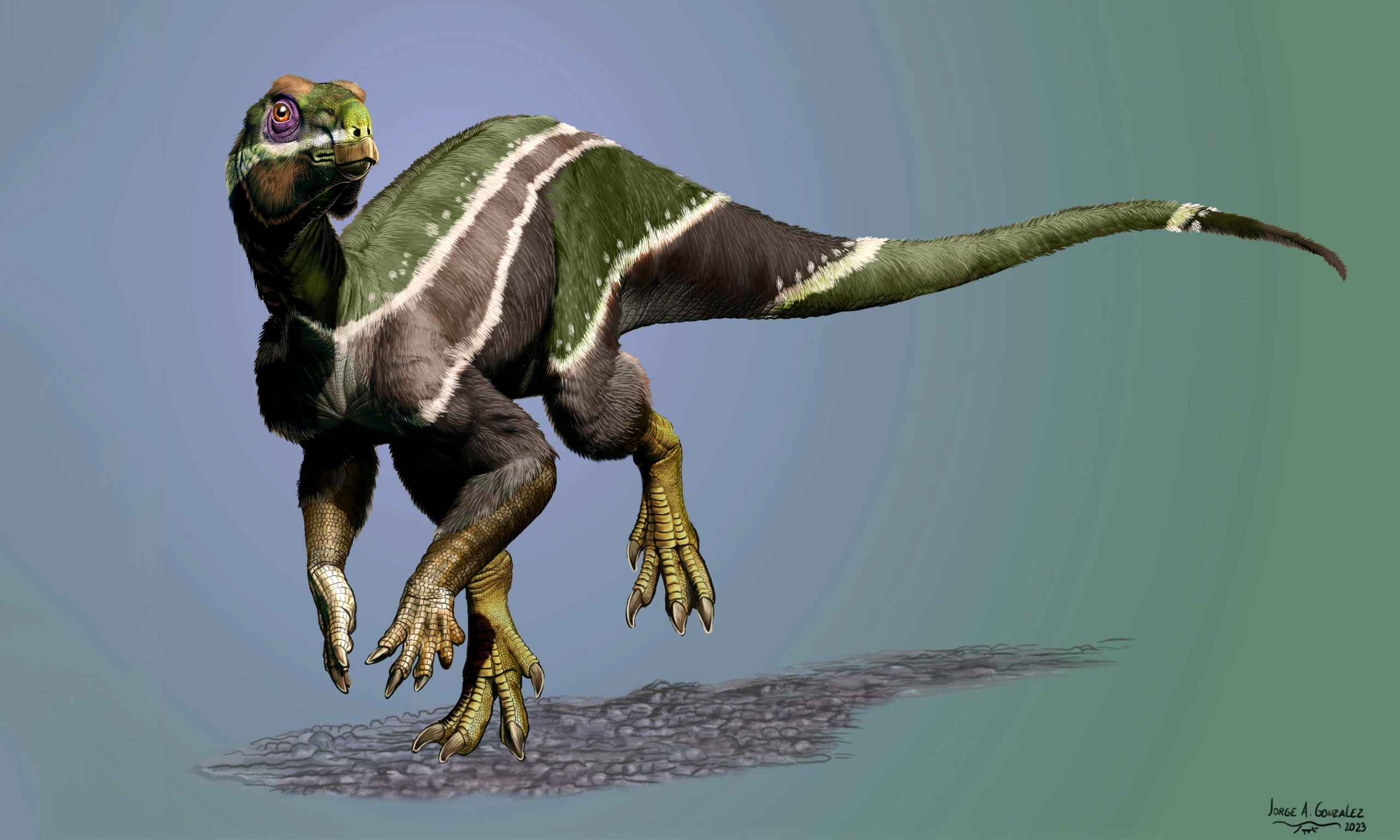إعادة بناء الفنان إاني سميثي. قد يمثل هذا الديناصور المبكر أورنيثوبود المكتشف مؤخرًا الاستيطان النهائي لأحد الأنواع خلال فترة الاحتباس الحراري في منتصف العصر الطباشيري ، منذ حوالي 99 مليون سنة ، مما أدى إلى تغييرات جذرية في تجمعات الديناصورات. 1 رصيد
الديناصور المكتشف حديثًا ، إاني سميثيعاش خلال الاضطرابات المناخية للبيئة[{” attribute=””>Cretaceous era and might be the last of its lineage, replaced by duckbill dinosaurs. This dinosaur, found in Utah, represents a critical transitional period in dinosaur history, affected by rising CO2 levels, global warming, and shifting dinosaur populations.
A newly discovered plant-eating dinosaur may have been a species’ “last gasp” during a period when Earth’s warming climate forced massive changes to global dinosaur populations.
The specimen, named Iani smithi after Janus, the two-faced Roman god of change, was an early ornithopod, a group of dinosaurs that ultimately gave rise to the more commonly known duckbill dinosaurs such as Parasaurolophus and Edmontosaurus. Researchers recovered most of the juvenile dinosaur’s skeleton – including skull, vertebrae and limbs – from Utah’s Cedar Mountain Formation.
Iani smithi lived in what is now Utah during the mid-Cretaceous, approximately 99 million years ago. The dinosaur’s most striking feature is its powerful jaw, with teeth designed for chewing through tough plant material.
https://www.youtube.com/watch؟v=KiAA2AVYop4
كان منتصف العصر الطباشيري وقت تغيير كبير ، كان له تأثيرات كبيرة على مجموعات الديناصورات. أدت الزيادة في ثاني أكسيد الكربون في الغلاف الجوي خلال هذه الفترة إلى ارتفاع درجة حرارة الأرض وارتفاع مستويات سطح البحر ، مما أدى إلى دمج الديناصورات في كتل أرضية أصغر وأصغر. كان الجو حارًا لدرجة أن الغابات المطيرة ازدهرت عند القطبين. غزت الحياة النباتية المزهرة المناطق الساحلية وحلت محل مصادر الغذاء الطبيعية للحيوانات العاشبة.
في أمريكا الشمالية ، الصربوديات العملاقة العاشبة – التي كانت جبابرة المناظر الطبيعية – تختفي جنبًا إلى جنب مع مفترساتها الالوصورية. في الوقت نفسه ، كانت آكلات النباتات الأصغر حجمًا ، مثل منقار البط القديم والديناصورات ذات القرون ، والثيروبودات ذات الريش مثل التيرانوصورات والأفيرابتوروصورات الهائلة ، تصل من آسيا.
يدخل إاني سميثيفريد ليس فقط لأنه تم اكتشافه للتو ، ولكن أيضًا بسبب ندرته في سجل الحفريات في أمريكا الشمالية ومكانته في تاريخ الديناصورات.
“اكتشاف إياني كان صدفة. علمنا أن شيئًا كهذا عاش في هذا النظام البيئي لأنه تم جمع الأسنان المعزولة هنا وهناك ، لكننا لم نتوقع أن نصادف مثل هذا الهيكل العظمي الجميل ، خاصة في هذا الوقت من تاريخ الأرض. كان امتلاك جمجمة شبه كاملة أمرًا لا يقدر بثمن في تجميع التاريخ معًا “، كما تقول ليندسي زانو ، أستاذة الأبحاث المشاركة في[{” attribute=””>North Carolina State University, head of paleontology at the North Carolina Museum of Natural Sciences, and corresponding author of the work.

The lower jaw and teeth of new dinosaur Iani smithi. Credit: National Geographic, Mark Thiessen and Becky Hale
Zanno and her team used the well-preserved skeleton to analyze the evolutionary relationships of Iani and were surprised – and a bit skeptical – of the results.
“We recovered Iani as an early rhabdodontomorph, a lineage of ornithopods known almost exclusively from Europe,” Zanno says. “Recently, paleontologists proposed that another North American dinosaur, Tenontosaurus – which was as common as cattle in the Early Cretaceous – belongs to this group, as well as some Australian critters. If Iani holds up as a rhabdodontomorph, it raises a lot of cool questions.”
Key among these is, could Iani be a last gasp, a witness to the end of a once successful lineage? Zanno thinks that studying this fossil in the context of environmental and biodiversity changes during the mid-Cretaceous will give us more insight into the history of our planet.
Iani smithi is named for Janus, the two-faced god who symbolized transitions – an apt name, given its position in history.
“Iani may be the last surviving member of a lineage of dinosaurs that once thrived here in North America but were eventually supplanted by duckbill dinosaurs,” Zanno says. “Iani was alive during this transition – so this dinosaur really does symbolize a changing planet.
“This dinosaur stood on the precipice,” she says, “able to look back at the way North American ecosystems were in the past, but close enough to see the future coming like a bullet train. I think we can all relate to that.”
Reference: “An early-diverging iguanodontian (Dinosauria: Rhabdodontomorpha) from the Late Cretaceous of North America” by Lindsay E. Zanno, Terry A. Gates, Haviv M. Avrahami, Ryan T. Tucker and Peter J. Makovicky, 7 June 2023, PLOS ONE.
DOI: 10.1371/journal.pone.0286042
The work appears in PLOS ONE and was supported by the National Science Foundation. Zanno is lead author as well as corresponding. Terry Gates and Haviv Avrahami, both of NC State and the North Carolina Museum of Natural Sciences, along with Ryan Tucker of Stellenbosch University and Peter Makovicky of the University of Minnesota, also contributed to the work.

“هواة الإنترنت المتواضعين بشكل يثير الغضب. مثيري الشغب فخور. عاشق الويب. رجل أعمال. محامي الموسيقى الحائز على جوائز.”





